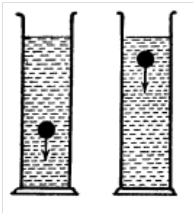Viscosity
When we move our fingers through any liquid we experience a resistance. This is because liquid offers a frictional force. The resistance offered by fluids (liquids as well as gases) to relative motion between its different layers is called viscous force. This property is called viscosity. The viscous forces are similar to frictional forces which resist relative motion between two bodies in contact. To observe this, we can take two long cylinders, one filled with water while the other filled with glycerine.

We take two identical lead shots and drop one in water and the other in glycerine at the same time. We see that the lead shot dropped in water comes down more quickly and the lead shot in glycerine descends slowly. This implies that the viscous force is more in the case of glycerine than that in the case of water.
Flow of liquid through Pipes
There are two types of flows viz. streamlined flow and turbulent flow.
- If all the particles of the liquid pass across a point with the same velocity, the flow is said to be stream lined. In this flow, a particle follows the same path throughout its motion.
- If the particles pass across a point with different velocities, the flow is turbulent. In this flow, a particle does not follow the same path throughout its motion.
When a liquid flows slowly and steadily through a pipe, the velocity of the layer of the liquid in contact with the walls of the pipe is zero. As we move towards the axis of the tube, the velocity of the layers gradually increases and reaches a maximum value along the axis of the tube. In the case of streamlined flow of a river, the velocity is maximum for water on the upper layer (surface) of river . The velocity is minimum for water in the bottom most layer. When two parallel layers of a liquid are moving with different velocities, they experience tangential forces which tend to retard the faster layer and accelerate the slower layer. These forces are (F) called viscous forces. Newton found that the viscous force is:
- Directly proportional to the common area (A) of the liquid layers in contact.
- Directly proportional to their relative velocity (v1 – v2).
- Inversely proportional to the distance (x) between them.
This can be represented by the following formula:

Where η is a constant known as coefficient of viscosity of the liquid and (v1-v2)/x is called the velocity gradient. The unit of coefficient of viscosity is N s m-2 or Poise. The values of coefficient of viscosity are different for different liquids as shown in the below table:
[table id=”6″]Applications of Viscosity in Everyday Life
- The motion of falling raindrops is opposed by the viscous force offered by air. Hence the rain drops falls slowly.
- The viscosity of sea water makes the waves subside during a storm.
- The motion of objects in fluids depends upon the viscosity of the fluids.
The viscous force of water or air opposes the motion of ships, cars, aeroplane etc. hence their shapes are streamlined in order to minimise the viscous drag on them.
Working of Lubricants
Friction reduces the efficiency of a machine by converting mechanical energy into heat energy and causes much wear and tear of the moving parts. Friction is reduced by using lubricants. High molecular weight compounds such as hexanol are added as viscosity index improvers. The lubricant forms a thin layer between the two surfaces in contact. It also fills the depressions present in the surfaces of contact and reduces friction considerably. In light machinery, thin oils (e.g., clock oil) with low viscosity are used. In heavy and fast moving machinery solids or thick highly viscous oils (e.g., grease) are used. By adding long chain polymers with lubricating oil, its coefficient of viscosity is kept constant even at high temperatures.
Properties of Good Lubricants
A good lubricant should have the following properties:
- It should be able to spread and fill up the minute depressions in the surfaces.
- It should be chemically inert and should not undergo any decomposition at high temperature.
- It should be capable of conducting away the heat produced by friction.
Viscosity of Blood
If the arteries and veins of human body contract and become hard, their diameters decrease. Hence the flow of blood is affected due to the viscosity of blood and the blood pressure increases. This affects the functioning of heart. When the temperature of human body increases during fever, the coefficient of viscosity of blood decreases. This increases the blood circulation and the normal heart functioning is maintained.


ANBAZHAGAN J
November 15, 2014 at 11:57 pmVery nice and will be more useful.Thanks for the content
madhubala
March 26, 2015 at 8:42 pmthank you so much,It was very helpful for my project:-)